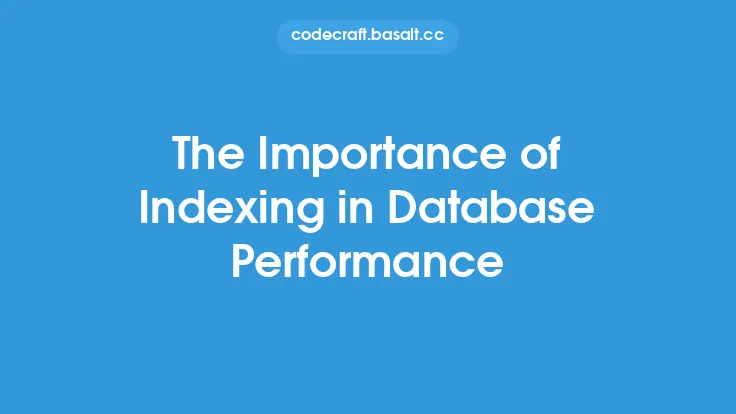Indexing is a crucial aspect of query optimization in database systems, allowing for faster data retrieval and improved overall performance. At its core, an index is a data structure that facilitates quick lookup, efficient ordering, and fast access to data. By creating an index on one or more columns of a table, the database can quickly locate specific data without having to scan the entire table, resulting in significant performance gains.
Introduction to Indexing
Indexing works by creating a separate data structure that contains the indexed columns and a pointer to the location of the corresponding rows in the table. This allows the database to quickly locate specific data by searching the index rather than scanning the entire table. Indexes can be created on one or more columns, and can be used to speed up various query operations, including SELECT, INSERT, UPDATE, and DELETE.
Types of Indexes
There are several types of indexes that can be used in database systems, each with its own strengths and weaknesses. The most common types of indexes include:
- B-tree indexes: These are the most common type of index and are used to index data that is stored in a B-tree data structure. B-tree indexes are efficient for range queries and are often used as the default index type.
- Hash indexes: These are used to index data that is stored in a hash table data structure. Hash indexes are efficient for equality queries and are often used in conjunction with B-tree indexes.
- Full-text indexes: These are used to index large amounts of unstructured data, such as text documents. Full-text indexes are efficient for searching and retrieving data based on keywords or phrases.
- Bitmap indexes: These are used to index data that is stored in a bitmap data structure. Bitmap indexes are efficient for queries that involve multiple conditions and are often used in data warehousing applications.
Indexing Strategies
When it comes to indexing, there are several strategies that can be used to optimize query performance. Some of the most effective indexing strategies include:
- Indexing frequently used columns: Columns that are frequently used in WHERE, JOIN, and ORDER BY clauses should be indexed to improve query performance.
- Indexing columns with high cardinality: Columns with high cardinality (i.e., many unique values) should be indexed to improve query performance.
- Avoiding indexing columns with low cardinality: Columns with low cardinality (i.e., few unique values) should not be indexed, as this can lead to decreased query performance.
- Using composite indexes: Composite indexes, which index multiple columns, can be used to improve query performance when multiple columns are used in a query.
- Using function-based indexes: Function-based indexes, which index the result of a function, can be used to improve query performance when a function is used in a query.
Index Maintenance
Indexes require regular maintenance to ensure optimal performance. Some of the most important index maintenance tasks include:
- Rebuilding indexes: Indexes should be rebuilt regularly to ensure that they remain efficient and effective.
- Reorganizing indexes: Indexes should be reorganized regularly to ensure that they remain efficient and effective.
- Updating index statistics: Index statistics should be updated regularly to ensure that the database has accurate information about the index.
- Monitoring index usage: Index usage should be monitored regularly to ensure that the index is being used effectively and to identify areas for improvement.
Best Practices for Indexing
When it comes to indexing, there are several best practices that can be followed to optimize query performance. Some of the most effective best practices include:
- Keeping indexes simple: Indexes should be kept simple to ensure that they are easy to maintain and optimize.
- Avoiding over-indexing: Too many indexes can lead to decreased query performance, so it's essential to avoid over-indexing.
- Using the correct index type: The correct index type should be used for the specific query and data type.
- Testing and monitoring indexes: Indexes should be tested and monitored regularly to ensure that they are effective and efficient.
Common Indexing Mistakes
When it comes to indexing, there are several common mistakes that can be made, including:
- Indexing too many columns: Indexing too many columns can lead to decreased query performance and increased storage requirements.
- Not indexing frequently used columns: Failing to index frequently used columns can lead to decreased query performance.
- Using the wrong index type: Using the wrong index type can lead to decreased query performance and increased storage requirements.
- Not maintaining indexes: Failing to maintain indexes can lead to decreased query performance and increased storage requirements.
Conclusion
Indexing is a powerful tool for optimizing query performance in database systems. By creating an index on one or more columns of a table, the database can quickly locate specific data without having to scan the entire table, resulting in significant performance gains. By understanding the different types of indexes, indexing strategies, and best practices for indexing, database administrators can optimize query performance and improve overall database efficiency. Regular index maintenance and monitoring are also essential to ensure that indexes remain effective and efficient over time. By following these guidelines and avoiding common indexing mistakes, database administrators can unlock the full potential of indexing and take their database performance to the next level.





